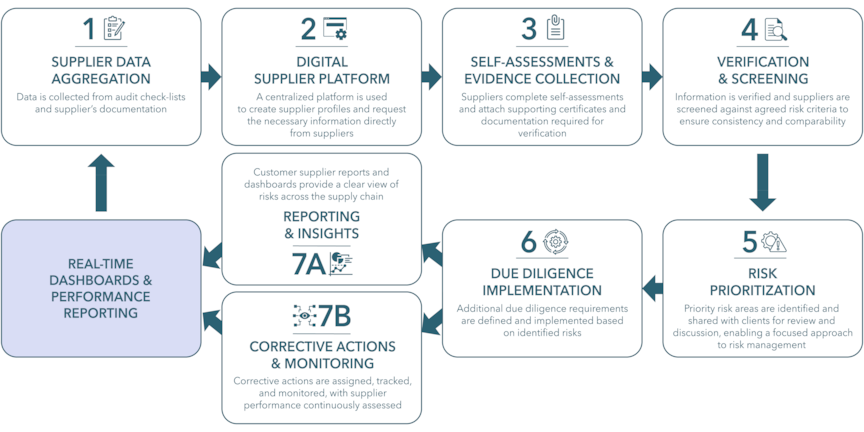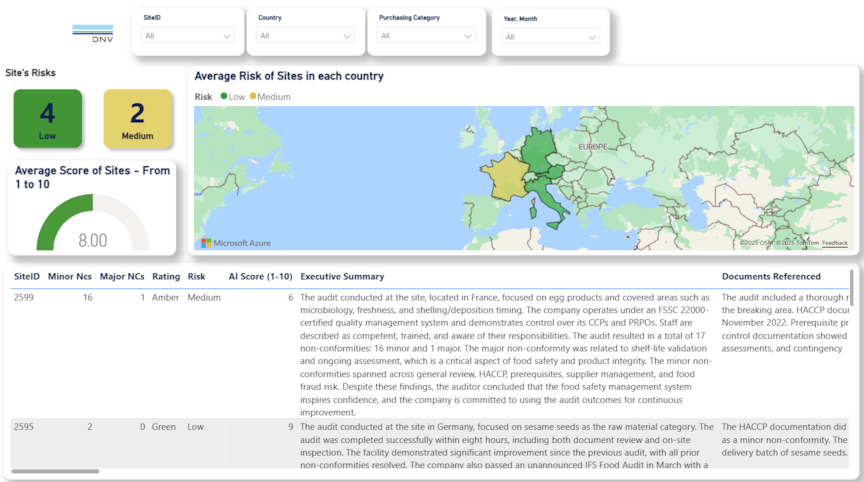Supply chain management & monitoring
DNV helps organizations gain visibility, reduce risks, and improve performance across complex supply chains through tailored monitoring and management solutions.
Supply chain management & monitoring
Managing complexity and compliance across modern supply chains
Global supply chains are under more pressure than ever. Geopolitical shifts, sustainability requirements, regulatory changes, and increasing consumer expectations demand greater transparency and control. Companies are now expected to monitor supplier performance, ensure responsible sourcing, and proactively manage disruptions.
Yet many still rely on fragmented or manual approaches that limit visibility and expose the business to risk. A strategic, data-driven supply chain monitoring program is essential for long-term resilience and trust.
How our supply chain management services support you
DNV’s Supply chain management & monitoring service offers a comprehensive solution to assess, monitor, and improve supplier performance across your global value chain. Our approach blends digital platforms, on-the-ground audits, and expert analysis to help organizations monitor key risk areas, support supplier development, and achieve strategic compliance and sustainability goals.
Our service supports you to:
- Identify and assess supply chain risks.
- Monitor supplier compliance with ESG, quality, and safety standards.
- Track critical data and performance metrics.
- Support supplier development and corrective actions.
- Enable continuous improvement and regulatory alignment.

The service can be tailored to your industry, product category, or internal sourcing policies, whether for a single tier or full multi-tier monitoring.

Global assurance leader with cross-sector experience
DNV is a leading independent assurance and risk management provider operating in over 100 countries. We specialize in helping companies build supply chains that are not only compliant and transparent, but also resilient and performance oriented.
With deep industry expertise across automotive, food & beverage, rail, aquaculture, medical devices, and healthcare, we offer a uniquely integrated combination of on-the-ground assessments, remote monitoring, and data analytics to support organizations in navigating supply chain complexity and achieving long-term value.

Benefits of our supply chain management services
- Improve supplier transparency, reliability, and accountability.
- Detect and mitigate risks before they impact your business.
- Ensure compliance with regulatory and customer requirements.
- Reduce administrative burden through digital automation.
- Enhance stakeholder trust and brand reputation.
- Enable continuous improvement through verified data.
When trust matters: proven results from DNV’s supply chain partners
See how our clients have enhanced compliance, resilience, and sustainability through DNV’s assurance and monitoring expertise.

Download the 2024 Sustainable Food Supply Chain Report
Uncover the latest insights – from meeting regulatory demands to staying competitive. Learn how to help align sustainability goals, meet consumer expectations, and foster long-term resilience.

DNV partners with Diageo in Brazil to strengthen supply chain governance through the impactful License to Operate project
Discover how DNV’s technical and digital expertise supported Diageo to implement a nationally standardized model for supplier compliance now recognized as a benchmark across global operations.

Barilla's commitment to food safety, with the contribution of DNV
For many years, DNV’s independent verification has supported Barilla in conducting second-party audits on supply chain control and raw material traceability.
Contact us






